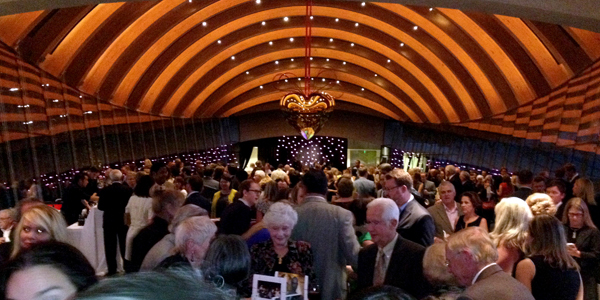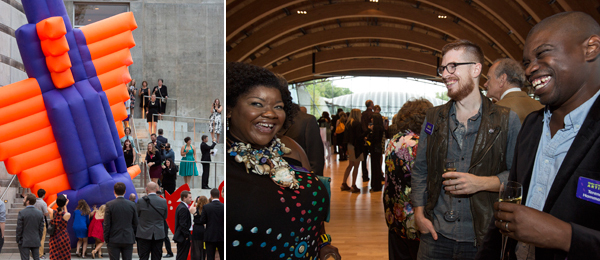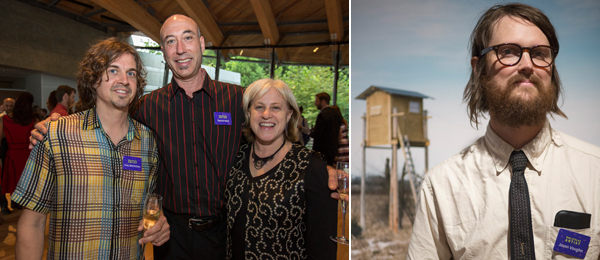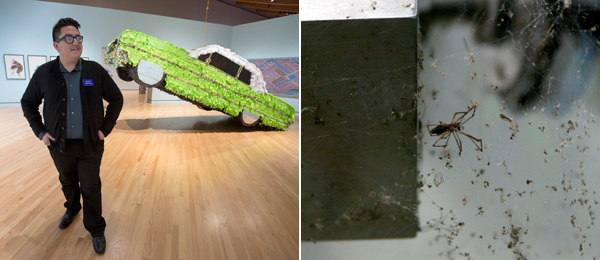By Travis Diehl via artforum.com

Curator Chad Alligood, artist Angela Ellsworth, and Crystal Bridges president
Don Bacigalupi in the Great Hall. (Photo: Marc F. Henning)
“THE LONG-JAWED ORB SPIDER and the common house spider are perennial visitors to Crystal Bridges in the summer and early fall.”
As I walked from one end of the Crystal Bridges Museum’s vaulted entrance lobby and restaurant, beneath a big gold Jeff Koons heart, across one of two enclosed suspension bridges spanning the natural spring that lends the building its name, a wall label caught my eye. “These opportunistic predators build their webs in the Museum’s large, illuminated windows to take advantage of the many insects that are attracted to them by night. Our grounds crew uses a variety of environmentally friendly methods,” it reads, “of discouraging the spiders; however, the hungry arachnids persist. The return of cool temperatures in the fall will eliminate the spiders eventually.” Outside, a warm rain darkened the building’s concrete. “In the meantime, enjoy this close-up look at Mother Nature at work.”
Today, though, the grounds crew made an exception and swept out the webs. It was September 11, 2014: opening day for “State of the Art”—the museum’s ambitious survey of 102 “underrecognized” artists from across the Union. A pair of dedicated curators had braved some hundred thousand road miles, 250 commercial airline flights, and way more studio visits than you can shake a Whitney Biennial at—ultimately arriving, without regional or demographic quotas, at a group nearly, remarkably, as diverse as the national spread. All this tucked away in Bentonville, Arkansas, an Ozark enclave half an hour from the nearest regional airport—more famous, truth be told, as the corporate capital of Walmart than for its art. But they aim to change all that.

Left: Artist Dan Steinhilber. (Photo: Travis Diehl) Right: Artists Miki Baird,
Pam Longobardi, and Vanessa German. (Photo: Marc F. Henning)
Curatorial team Chad Alligood and Don Bacigalupi (who is also the museum’s president) led a pack of press on a brisk tour through nineteen thousand square feet of exhibition space, unfurling, with the help of a few highlights, their philosophy. The viewer enters the show, for example, through a tunnel of collaged crochet by Brooklyn’s Jeila Gueramian. “If you’re searching for meaning,” said Bacigalupi, “the answer is, it’s you”—the work’s title. Your interpretation, your experience, your vision. (Indeed, poking through embroidered cats and yarn tentacles, I noted, are a peyote cactus or two—but who’s to judge?) Further in, we paused beside Ialu by John Douglas Powers, where a little motor on a spit dipped plant stalks back and forth near a projection of puffy clouds, like a line of oarsmen chained to a waves-of-grain machine. Next door was a gigantic mural by Gina Phillips, made of thread, showing, amid a busy rural scene, a corn plant sprouting from the artist’s shin.
Whether the work is engaged in biography, history, politics, or craft, the chief criteria is time-tested: virtuosity. Missing the references won’t keep you from enjoying this work. Such self-evident skill, in one view, shrugs off the pretentious, insular discourse that marks much contemporary art. We passed, without comment, Hamilton Poe’s Stack: a number of straw hats sitting on box fans, fixed to the wall floor-to-ceiling in the manner of a Judd stack, in the spot where the museum usually displays its Judd.
In the dining room, the group gathered around Matthew Moore’s Lifecycles, a video of lettuce and carrots maturing in time-lapse. This piece also hangs in a couple of regional Walmart produce sections. “If you knew it took 160 days to grow a carrot,” the label quotes the artist as saying, “it might change the way you think about the produce that you bought.” The label also directs the viewer to a work in the Crystal Bridges collection: Thomas Hart Benton’s 1934 Ploughing It Under, a painting of a black farmer guiding a plow behind a blinkered horse. A lot of things might change the way you think, if you knew them. Some might find the combination of technical skill and soft politics a fence for thornier questions. A lack of agrarian awareness, for one, is the least of the charges leveled against Walmart stores. The tour concluded with a Q&A backlit by a wall painting and projection by New Orleanean Dave Greber. In the top left, the gold mask of Agamemnon—power, formerly consolidated in a figurehead—melts into a trickle-down rainbow that runs past rhinestones, under painted bridges. The piece certainly supports interpretation as a diagram of Walton-family largesse.
I joined the curators for a pleasant lunch in the spider-free museum restaurant. Somewhere in the middle, Walmart heiress and eleventh-richest human on the planet Alice Walton stopped by our table to say howdy. For the past ten years, she’s been collecting art with the museum in mind; she was heart and soul of the effort to build and endow a world-class American institution in her father Sam Walton’s adopted hometown (what Bacigalupi neutrally described as “a company town, but anti-union”). This is her building, if not her program. But to be fair, Crystal Bridges hasn’t had as much time as, say, MoMA or the Whitney to diversify its robber-baron underwriters.

At the opening night dinner for “State of the Art.” (Photo: Travis Diehl)
In the meantime, depending on your perspective, the institution enjoys a kind of bad-boy/little-guy/new-money status, along with the nickname “The Walmart Museum.” I asked the curators if they feel isolated in a town of Bentonville’s stature. “Far from it,” they said. Yokels, they ain’t. Alligood was scouted from the Cranbrook Art Museum, while Bacigalupi has held top museum jobs in San Diego and San Antonio. The mobility of a young, pioneering collection, in their view, gives them the option to be generous, instead of closed, as regards the heartland. Crystal Bridges occupies something like a nonjudgmental state of nature, suspended between coastal art capitals—able to pick and choose from their “civilizing” influences. In fact, they’ve got the resources, the positioning, the weight, to bend the map their way: toward the middle.
Some folks, though, in New York and Los Angeles especially, think a few works in the Crystal Bridges collection don’t belong among the hillbillies. What art, in particular? In a nineteenth-century collection sprinkled with Sargants and Eakinses: Asher B. Durand’s Kindred Spirits—which used to hang in the main branch of the New York Public Library. Or a portrait of then general George Washington by Charles Willson Peale. His hand rests on a brass cannon symbolizing the military might and readiness of the fledgling United States. Behind the rosy-cheeked commander-in chief, a dark sky parts around a slash of blue. “Only the flag,” says the label, stands higher in the composition. You don’t need a degree in Judd to appreciate this kind of symbolism.
Under cover of flat, unthreatening clouds, I took a stroll on the Art Trail—a long sidewalk, dotted with the likes of a Cor-Ten Robert Indiana and a James Turrell sky room, connecting the museum’s south entrance with downtown Bentonville. The museum grounds include several miles of paths—proof, according to locals, of Alice Walton’s love for this place, which was built on Walton family land parceled to the museum with the blessing of her nieces and nephews. The Bentonville square is old-timey but obviously remodeled. On one side is Sam Walton’s first store, the 5&10, which is now the actual Walmart museum—the one about Walmart. On the other is the courthouse. The flag waved at half-mast.

Left: At Bentonville’s square. Right: Charles Willson Peale’s portrait of George Washington on the audio guide.
(Photos: Travis Diehl)
Later that night the museum hosted a bigger turnout than for the inaugural gala almost three years prior: twelve hundred artists and artists’ families, curators, patrons—all, for the most part, proud as can be. One couple had traveled from Atlanta for the opening; they’d commissioned one of the sculptures, Bob Trotman’s Journey (Ladder), as a gift for their forty-fifth anniversary. I spent a long time with two women in Dan Steinhilber’s mylar-lined Reflecting Room, waiting for the walls to deflate. The thin foil on the floor had been torn in places by high heels. Eventually we gave up. “We’ll tell our husbands that it did,” they said. When I emerged, caterers were packing up the drinks. I threaded my way through a disintegrating party, back down the Art Path in the dark, with a bunch of New Yorkers. Bentonville also boasts a 21c, one of a small chain of boutique art hotels catering to regional hubs like Cincinnati and Louisville, which, rather than a hotel-looking edifice crammed with art, looks just like a modern kunsthalle. Their bar was the only one in town still open.
“I’m gonna shop at Walmart the rest of my goddamn life,” said Guy W. Bell, an artist from Little Rock, Arkansas, only half joking. His contribution to the show is Cain and Abel, an oil painting of two dogs, a black one and a white one, fighting in a road. Arkansas is a special place, he says. There are problems, but they get worked out in straight-shooting, albeit often violent ways. And here was a man who appreciates the richness of his state, its weird cosmopolitan confluences, the beauty of its brutal nature. He ranged over topics from fine wine to bar fights to woodworking accidents to the decline of boxing from its Tyson-era pinnacle. What has replaced boxing, in the national mythology? Bell didn’t miss a beat: “Politics.”
Back in my room, I flipped on the TV while I packed. Opposite infomercials and televangelists, MSNBC showed unanchored, unamended, thirteen-year-old coverage of the Twin Towers’ collapse—what I can only describe as 9/11 reruns.

Left: Artist Jimmy Kuehnle walks across Walker Landing setting up his inflatable work. Right: Artists Vanessa German, Jimmy Baker, and Terence Hammonds. (Photo: Marc F. Henning)

Left: Artists Dan Steinhilber and Danial Nord (left and center). Right: Artist Jason Vaughn. (Photos: Marc F. Henning)

Left: Artist Justin Favela. (Photo: Marc F. Henning) Right: Nature in art. (Photo: Travis Diehl)
